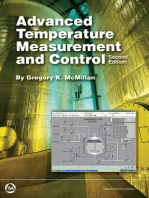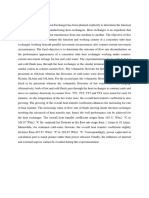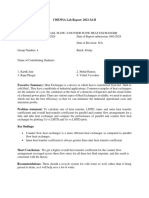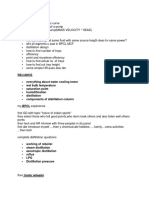0 ratings0% found this document useful (0 votes)
29 viewsExecutive Summary
Executive Summary
Uploaded by
jeswin354This laboratory report analyzes experiments comparing heat transfer rates in parallel and counter flow operations using two types of heat exchangers. The experiments found that countercurrent flow provided greater heat transfer than parallel flow in both a shell and tube exchanger and a tubular exchanger. While the shell and tube exchanger had a higher temperature difference, the tubular exchanger offered a slightly higher average heat flow due to its larger average area of heat transfer.
Copyright:
© All Rights Reserved
Available Formats
Download as DOCX, PDF, TXT or read online from Scribd
Executive Summary
Executive Summary
Uploaded by
jeswin3540 ratings0% found this document useful (0 votes)
29 views2 pagesThis laboratory report analyzes experiments comparing heat transfer rates in parallel and counter flow operations using two types of heat exchangers. The experiments found that countercurrent flow provided greater heat transfer than parallel flow in both a shell and tube exchanger and a tubular exchanger. While the shell and tube exchanger had a higher temperature difference, the tubular exchanger offered a slightly higher average heat flow due to its larger average area of heat transfer.
Original Description:
jh
Original Title
hj
Copyright
© © All Rights Reserved
Available Formats
DOCX, PDF, TXT or read online from Scribd
Share this document
Did you find this document useful?
Is this content inappropriate?
This laboratory report analyzes experiments comparing heat transfer rates in parallel and counter flow operations using two types of heat exchangers. The experiments found that countercurrent flow provided greater heat transfer than parallel flow in both a shell and tube exchanger and a tubular exchanger. While the shell and tube exchanger had a higher temperature difference, the tubular exchanger offered a slightly higher average heat flow due to its larger average area of heat transfer.
Copyright:
© All Rights Reserved
Available Formats
Download as DOCX, PDF, TXT or read online from Scribd
Download as docx, pdf, or txt
0 ratings0% found this document useful (0 votes)
29 views2 pagesExecutive Summary
Executive Summary
Uploaded by
jeswin354This laboratory report analyzes experiments comparing heat transfer rates in parallel and counter flow operations using two types of heat exchangers. The experiments found that countercurrent flow provided greater heat transfer than parallel flow in both a shell and tube exchanger and a tubular exchanger. While the shell and tube exchanger had a higher temperature difference, the tubular exchanger offered a slightly higher average heat flow due to its larger average area of heat transfer.
Copyright:
© All Rights Reserved
Available Formats
Download as DOCX, PDF, TXT or read online from Scribd
Download as docx, pdf, or txt
You are on page 1of 2
Executive Summary
This laboratory report presents a detailed analysis on a series of experiments conducted to
compare the heat transfer rate in both parallel and counter flow operation in two types of
heat exchanger. This experiment was completed with the ‘WL 110-SERIES’ heat exchanger
service unit using a shell and tube heat exchanger as well as a tubular heat exchanger. Setting
the desired flow rate and setpoint temperature, the temperature plots and various
parameters were noted, observed and the results are discussed in detail in this report. In both
types of heat exchangers, it was observed that greater heat transfer rate was obtained in a
countercurrent design as opposed to a parallel flow design. The temperature gradient
observed in the temperature plots showed a constant flow of heat and great heat recovery
rate in the countercurrent connections in both the types of heat exchangers. Selecting the
right type of heat exchanger depends on many factors like pressure drop, area of heat
transfer, temperature, type of application etc. In this experiment the tubular heat exchanger
offered slightly greater mean heat flow than the shell and tube heat exchanger owing to its
greater mean average area of heat transfer which eclipsed the higher LMTD obtained by the
shell and tube exchanger.
You might also like
- Heat ExchangerDocument21 pagesHeat ExchangersedamyrulNo ratings yet
- Advanced Temperature Measurement and Control, Second EditionFrom EverandAdvanced Temperature Measurement and Control, Second EditionNo ratings yet
- Air Cooled Heat Exchanger Handbook: Fundamentals, Calculations, Design and Q&AFrom EverandAir Cooled Heat Exchanger Handbook: Fundamentals, Calculations, Design and Q&ANo ratings yet
- Heat Exchanger ReportDocument16 pagesHeat Exchanger ReportMahmoud Hendawy100% (5)
- Heat Exchanger Group 17Document22 pagesHeat Exchanger Group 17ja ma0% (1)
- Stirred Tank ReactorsDocument38 pagesStirred Tank ReactorsJimNo ratings yet
- Shell and Tube Heat ExchangerDocument31 pagesShell and Tube Heat ExchangerDhiyyah Mardhiyyah100% (1)
- Experiment of Shell & Tube Heat ExchangerDocument29 pagesExperiment of Shell & Tube Heat ExchangerNanaNaurah9578% (9)
- Lab 5 Heat ExchangerDocument13 pagesLab 5 Heat ExchangerNur Syuhaidah100% (1)
- Heat 4e Chap11 LectureDocument32 pagesHeat 4e Chap11 LectureSalim ChohanNo ratings yet
- Shell and Tube Heat ExhangerDocument28 pagesShell and Tube Heat ExhangerAmoluck BhatiaNo ratings yet
- Con Cent Eric Tube Heat ExchangerDocument15 pagesCon Cent Eric Tube Heat ExchangerAmr BanawanNo ratings yet
- Abstract, Introduction, AppendixDocument4 pagesAbstract, Introduction, Appendixfarishelmifirst05No ratings yet
- Double Pipe Heat ExchangerDocument21 pagesDouble Pipe Heat ExchangerIsabel GarciaNo ratings yet
- COUNTER FLOW HEAT EXCHANGE (Heat Transfer)Document9 pagesCOUNTER FLOW HEAT EXCHANGE (Heat Transfer)hayder alaliNo ratings yet
- TurnitinDocument8 pagesTurnitinirfan hilmanNo ratings yet
- Tubular Heat Exchanger Lab ReportDocument21 pagesTubular Heat Exchanger Lab ReportMuhammad Zafrulhafiz80% (5)
- PressurenDrop in Double Pipe Heat ExchangersDocument5 pagesPressurenDrop in Double Pipe Heat ExchangersdikimNo ratings yet
- Concentric Tube Heat Exchanger ReportDocument19 pagesConcentric Tube Heat Exchanger Reportillyzl100% (1)
- Classification of Heat ExchangersDocument12 pagesClassification of Heat Exchangersvishal samundreNo ratings yet
- Ch-11 (HMT)Document44 pagesCh-11 (HMT)Fahad AbdullahNo ratings yet
- Final ReportDocument70 pagesFinal ReportSudarshan KulandhaivelNo ratings yet
- Heat Exchangers: Heat and Mass Transfer: Fundamentals & ApplicationsDocument32 pagesHeat Exchangers: Heat and Mass Transfer: Fundamentals & ApplicationsYiu PhNo ratings yet
- Heat ExchangerDocument26 pagesHeat ExchangerTasnim Arif100% (2)
- LAB SOLAHshell&TubeHeatExchangerDocument28 pagesLAB SOLAHshell&TubeHeatExchangerSo Lah MusaNo ratings yet
- Experiment 10 (Co-Current and Counter Flow)Document7 pagesExperiment 10 (Co-Current and Counter Flow)Nouman NisarNo ratings yet
- Double Pipe Heat Exchanger DesignDocument10 pagesDouble Pipe Heat Exchanger DesignRhumi ELfver ShawolNo ratings yet
- FEEDBACK Shell & Tube Heat ExchangerDocument8 pagesFEEDBACK Shell & Tube Heat ExchangerSuaid Tariq BalghariNo ratings yet
- Lab Report of Heat ExchangerDocument8 pagesLab Report of Heat ExchangerSalam Albaradie100% (8)
- Counter & ParallelDocument18 pagesCounter & ParallelHemapriyankaa PeriyathambyNo ratings yet
- Heat ExchangerDocument19 pagesHeat ExchangerSydney Jaydean KhanyileNo ratings yet
- Heat ExchangerDocument22 pagesHeat ExchangerIka ReanysNo ratings yet
- Heat 4e Chap11 LectureDocument32 pagesHeat 4e Chap11 Lecturepradeepgautam1010198No ratings yet
- Finned Tube R134a CondenserDocument12 pagesFinned Tube R134a CondensermattiturboNo ratings yet
- Heat TransferDocument13 pagesHeat TransferSARATH KRISHNAKUMARNo ratings yet
- Review On Comparative Study Between Helical Coil and Straight Tube Heat ExchangerDocument5 pagesReview On Comparative Study Between Helical Coil and Straight Tube Heat ExchangerSharat ChandraNo ratings yet
- Group 7 - EXP 4 Heat ExchangerDocument27 pagesGroup 7 - EXP 4 Heat ExchangeradninNo ratings yet
- IETEPune2094ijarseDocument13 pagesIETEPune2094ijarseVictor BettNo ratings yet
- FRI04 ExpE5Document12 pagesFRI04 ExpE5jtvarsha211148No ratings yet
- Water-To-Water Heat Transfer in Tube-Tube Heat Exchanger: Experimental and Analytical StudyDocument15 pagesWater-To-Water Heat Transfer in Tube-Tube Heat Exchanger: Experimental and Analytical StudyAhmad Arif SaktiNo ratings yet
- Heat Exchangers LectureDocument37 pagesHeat Exchangers LectureTerna Orlanda100% (2)
- Shell and Tube Heat ExchangerDocument36 pagesShell and Tube Heat ExchangerSiti Nurshahira67% (3)
- Shell and Tube Heat ExchangerDocument34 pagesShell and Tube Heat ExchangerJimNo ratings yet
- Shell and Tube Heat ExchangerDocument10 pagesShell and Tube Heat Exchangerahmadazaizeh0% (1)
- Heat Transfer LabDocument11 pagesHeat Transfer LabstopnaggingmeNo ratings yet
- Fabrication and Analysis of Counter Flow Helical Coil Heat ExchangerDocument12 pagesFabrication and Analysis of Counter Flow Helical Coil Heat ExchangerpkvssraoNo ratings yet
- Basics of Industrial Heat TransferDocument12 pagesBasics of Industrial Heat TransferPinaiNo ratings yet
- CHE245 Lab Report SOLTEQ Concentric TubeDocument46 pagesCHE245 Lab Report SOLTEQ Concentric TubeVuyiseka maqukwanaNo ratings yet
- Che245 Lab Report Solteq Concentric Tube Heat Exchanger UnitDocument10 pagesChe245 Lab Report Solteq Concentric Tube Heat Exchanger UnitSyafiq Sabran HasnanNo ratings yet
- CHE391A - Unit Operation Lab 2023-24-IIDocument13 pagesCHE391A - Unit Operation Lab 2023-24-IIjtvarsha211148No ratings yet
- Design of Shell and Tube Type Heat Exchanger Using CFD ToolsDocument4 pagesDesign of Shell and Tube Type Heat Exchanger Using CFD Toolsanil kasotNo ratings yet
- Shell and Tube Heat ExchangerDocument15 pagesShell and Tube Heat Exchangerishaqabubakar2019No ratings yet
- The Fundamentals of Heat ExchangersDocument4 pagesThe Fundamentals of Heat ExchangersJojie-Ann AlabarcaNo ratings yet
- Jmet 03 02 002Document6 pagesJmet 03 02 002pkvssraoNo ratings yet
- Thermal Modelling of Power Transformers Using Computational Fluid DynamicsFrom EverandThermal Modelling of Power Transformers Using Computational Fluid DynamicsNo ratings yet
- Respiration Calorimeters for Studying the Respiratory Exchange and Energy Transformations of ManFrom EverandRespiration Calorimeters for Studying the Respiratory Exchange and Energy Transformations of ManNo ratings yet
- Process Steam Systems: A Practical Guide for Operators, Maintainers, and DesignersFrom EverandProcess Steam Systems: A Practical Guide for Operators, Maintainers, and DesignersNo ratings yet
- Chemical Thermodynamics Lab 1 ReportDocument10 pagesChemical Thermodynamics Lab 1 Reportjeswin354No ratings yet
- Reliance Everything About Water Cooling Tower Wet Bulb Temperature Saturation Point Humidification Distillation Components of Distillation ColumnDocument2 pagesReliance Everything About Water Cooling Tower Wet Bulb Temperature Saturation Point Humidification Distillation Components of Distillation Columnjeswin354No ratings yet
- Topics For Reflux 2016 Poster Presentation: Department of Chemical Engineering Indian Institute of Technology GuwahatiDocument1 pageTopics For Reflux 2016 Poster Presentation: Department of Chemical Engineering Indian Institute of Technology Guwahatijeswin354No ratings yet
- Academic Writing TemplateDocument13 pagesAcademic Writing Templatejeswin354100% (1)
- Academic Writing TemplateDocument13 pagesAcademic Writing Templatejeswin354No ratings yet
































































